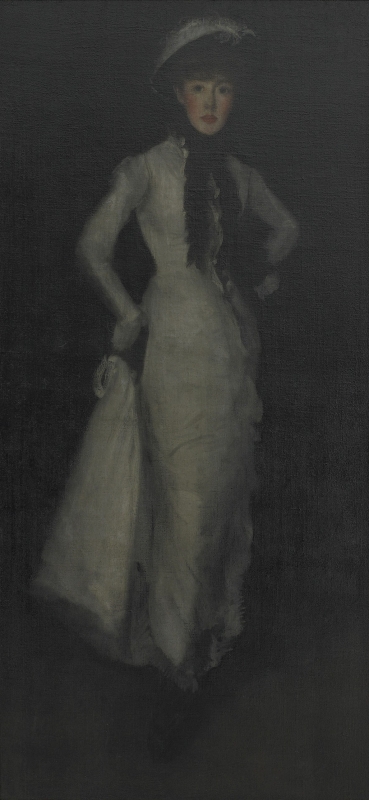Titles
Several possible titles have been suggested:
- 'Arrangement in White and Black' (1878, Grosvenor). 1
- 'Damenbildniss' (1897, Colnaghi's). 2
- 'Amerikanerin' (1903, E. Heilbut). 3
- 'Jeune femme dite L'Américaine' (1904, T. Duret) 4
- 'Arrangement in White and Black' (1980, YMSM). 5
According to Théodore Duret (1838-1927), the title of 'L'Américaine' was given to the picture in Germany, possibly due to a misunderstanding, since it was the artist, and not his sitter, who was American. 6
This might be considered the last of Whistler's 'White Girls' (see Symphony in White, No. 1: The White Girl [YMSM 038]). 7
'Arrangement in White and Black' is the preferred title.
Description
A full-length portrait of a woman in vertical format. She stands against a black background. She wears a close-fitting white dress, the train gathered and held at left in her right hand. She has a white bonnet and a black scarf. She stands with hands on hips, arms akimbo, and looks as if she is walking forward on her right leg.
Sitter
Whistler's mistress and chief model, Maud Franklin (1857-ca 1941) , posed for several major portraits, including Arrangement in Black and Brown: The Fur Jacket [YMSM 181], and many smaller drawings, paintings and prints.
Comments
A discussion of Maud's dress appears in Whistler, Women and Fashion:
'In Arrangement in White and Black, Maud fairly sizzled with youth and vigour. The close-fitting dress was the height of fashion. Contemporary cartoons mocked the fashionable woman’s inability to bend, climb stairs, and so on. “Shall we – a – sit down?” invites a gentleman at a dress party; “I should like to; but my Dressmaker says I mustn’t!” replies the young lady who must have been sewn into her dress. The Graphic for 4 May 1878 described a hat with delicate plumes curling over the brim just like Maud’s, and recommended similar costumes: “white sateen will be much worn, more or less trimmed with coloured ribbons … those whose features are irregular … can disguise their high foreheads with light curls, fringes etc … Bonnets and hats are very graceful … White or black, whether in silk, satin or tulle, form dress-bonnets and hats.” The figure-hugging satin dress was downright sexy and she strode out in a way that signalled sexual liberation. Her confrontational pose, hands on hips, offended the critics: the Magazine of Art considered it “vulgar in action”. The various elements that contributed to the image, including beauty and self-confidence, colour and costume, were analysed by an audience that was highly attuned to nuances of caste and class.' 8
Last updated: 29th December 2020 by Margaret







